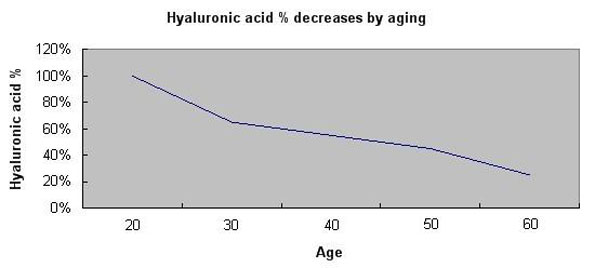
| China Office : Cactus Botanics Limited | USA Office : GB Biotech Inc. |
|---|---|
|
Add: 13/F-D,Block 2,No 628,Zhang Yang Road, Pudong New District, Shanghai, China, 200122 |
Add: 1108 W Valley Blvd#6278, Alhambra, CA 91803 |
| Ph:86-21-5169.6902 | Ph: 562.219.2167 |
| Fax:86-21-5106.2932 | Fax: 562.546.1323 |
Hyaluronic acid (also called Hyaluronan or hyaluronate or HA) is a linear polysaccharide with repeating disaccharide units composed of D-glucuronic acid and N-acetyl glucosamine. Hyaluronic acid is a naturally occurring biopolymer whose molecular structure is highly conserved between mammalian species.
Hyaluronic acid is distributed widely throughout connective, epithelial, and neural tissues. First described in 1934, it has since been used across a wide variety of medical fields as diverse as neurosurgery and cutaneous wound healing.
Hyaluronic acid is one of the main lubricating components of synovial joint fluid, and it has been shown to increase the viscosity of the fluid. Hyaluronic acid is also an important component of cartilage. HA-based products developed for osteoarthritis (called "viscosupplementation") aid in pain relief, as well as lubrication and cushioning of the joint.
The average 70 kg (154 lbs) person has roughly 15 grams of hyaluronan in the body, one-third of which is turned over (degraded and synthesized) every day. Skin contains large amount of hy-aluronic acid which amounts to about 1/3 of total hyaluronic acid existing in live body. The highest hyaluronic acid content in the body, for people, occurs in the embryonic period, and it gradually decreases after birth. Age, as well as exposure to the sun and pollution, leads to decreased pro-duction of hyaluronic acid, resulting in decr-
eased volume and the appearance of wrinkles. If the relative content of hyaluronic acid in the 20-year-old human body is positioned to 100%, it will drop to 65%, 45%, 25% respectively at the age of 30, 50, and 60 years old.

Hyaluronic acid is often used in formulation of skin care products, such as facial lotion, cream, because of its excellent moisture retention property. Hyaluronic acid ranges in size from 0.20×106-2.50×106 Da. Hyaluronic acid with different molecular weights has different functions in cosmetics.
| HA with different M.W | M.W Range | Function |
|---|---|---|
| Hight M.W | 1.80×106~2.50×106 | Hight water retention, promote the regeneration of the cell tissue |
| Common M.W | 1.00×106~1.80×106 | Keep skin moisture and lubrication for a long time. | Low M.W | 0.20×106~0.80×106 | Easily absorbed by skin, increase skin nutrition. |
| Recommended dosage: 0.05%-0.5%(subject to solid HA) | ||
Cactus Botanics offers Hyaluronic acid through several years' research and development. Now Cactus Botanics can offer Hyaluronic acid for Cosmetic Grade, Food Grade, Eye Drop Grade. Depending on your special requirements, Cactus Botanics, as a senior supplier in the raw material market, could provide the tailored formulation to meet your needs. Please email us for more information: info@cactusbotanics.com.
- 1.Frasher, J.R.E et al'; Laurent, T.C.; Laurent, U.B.G.(1997). "Hyaluronan: its nature, distribution, functions and turnover" (PDF). Journal of Internal Medicine 242 (1): 27–33. Retrieved 2009-06-05.
- 2.Stern R (August 2004). "Hyaluronan catabolism: a new metabolic pathway". Eur J Cell Biol 83 (7): 317–25.
- 3.Rutjes, AW; Jüni, P; da Costa, BR; Trelle, S; Nüesch, E; Reichenbach, S (2012 Aug 7). "Viscosupplementation for osteoarthritis of the knee: a systematic review and meta-analysis.". Annals of internal medicine 157 (3): 180–91.
- 4.Josefsson, A.; Adamo, H.; Hammarsten, P.; Granfors, T.; Stattin, P. R.; Egevad, L.; Laurent, A. E. M.; Wikström, P. et al. (2011). "Prostate Cancer Increases Hyaluronan in Surrounding Nonmalignant Stroma, and This Response is Associated with Tumor Growth and an Unfavorable Outcome". The American Journal of Pathology 179 (4): 1961–1968.
- 5.g. Gritsenko, P.; Ilina, O.; Friedl, P. (2012). "Interstitial guidance of cancer invasion". The Journal of Pathology 226 (2): 185–199.
- 6.De Andrés Santos MI, Velasco-Martín A, Hernández-Velasco E, Martín-Gil J, Martín-Gil FJ (1994). "Thermal behaviour of aqueous solutions of sodium hyaluronate from different commercial sources". Thermochim Acta 242: 153–160.
- 7.Shu XZ, Ghosh K, Liu Y, Palumbo FS, Luo Y, Clark RAF, Prestwich GD: Attachment and spreading of fibroblast on an RGD peptide-modified injectable hyaluronan hydrogel. J Biomed Materials Res, 68:365-75, 2004.
- 8."Hylan G-F 20 (Synvisc) approved by EMEA for pain due to ankle and shoulder OA". National Health Service. Retrieved 2007-07-09.
info@cactusbotanics.com. We will be honored to work with you.
 |
 |
|
|---|---|---|
| Novemember 14-15 , 2013 ▪ Las Vegas | The global nutraceutical event | |
| See us in booth#22012 | 6-8 May 2014 Geneva |
We will submit Issues 15th per month.
- Issue 5-6:(Jun 15, 2013): Highlights of Vitafoods Europe 2013
- Issue 4:(Apr 15, 2013): Applications for Brown Seaweed in Cosmetics
- Issue 3:(Mar 15, 2013): Botanical Extracts,Herbal Extracts,Amino Acids,API,Biochemical products-Cactus Botanics Limited
- Issue 2:(Feb 15, 2013): Shore Up Immunity with Our Ingredients
- Issue 1:(Jan 15, 2013): A New Look at Favorite Ingredients
